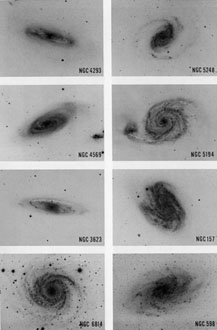


5.3 Spirals With Massive Arms
Massive-armed spirals form a second strain through the spiral sequence and are shown in Plate 4. No dominant spheroidal component is present for the galaxies illustrated here, even among the earliest types such as NGC 4293 [Sa or RSB (s)0/a] and 3623 [Sa or SAB (rs)a] in Plate 4. The reproductions emphasize that Hubble's three criteria do not always agree. The most obvious examples are 4293 and 4569 [Sb or SAB (rs)ab]. In such conflicting cases Hubble, Sandage, and de Vaucouleurs place most emphasis on the arm structure, and therefore classify such systems as Sa or early Sb despite the small spheroidal component. Besides the examples just mentioned, other such galaxies are NGC 4866 (Atlas, p. 11) and especially 4941 (Atlas, p. 10).

|
Plate 4. Progressive change of form of the massive-armed spirals from the earliest (NGC 4293, Sa) in the upper left, to the latest (M33, Scd) in the lower right. The nature of the arms changes continuously in the left column from top to bottom, and similarly in the right-hand column. Although all galaxies in this and the preceding two plates are of the same family (ordinary spirals), the difference in the arm structure pointed out by Reynolds (thin and filamentary in plates 2 - 3, and massive here) is evident. The division continues along the full length of the sequence from Sa to Sm. The plates were taken with the Mount Wilson or Palomar reflector. |
On the other hand, Morgan (cf. Section 7) emphasizes the relative size of the spheroidal component as his primary criterion. Morgan's system has advantages for certain problems because Morgan and Mayall (1957) show that the degree of dominance of the spheroidal component correlates well with integrated spectral type.